[/caption]
NASA’s super exciting Dawn mission to the Asteroid Belt marked a major milestone in human history by becoming the first ever spacecraft from Planet Earth to achieve orbit around a Protoplanet – Vesta – on July 16. Dawn was launched in September 2007 and was 117 million miles (188 million km) distant from Earth as it was captured by Asteroid Vesta.
Dawn’s achievements thus far have already exceeded the wildest expectations of the science and engineering teams, and the adventure has only just begun ! – so say Dawn’s Science Principal Investigator Prof. Chris Russell, Chief Engineer Dr. Marc Rayman (think Scotty !) and NASA’s Planetary Science Director Jim Green in exclusive new interviews with Universe Today.
As you read these words, Dawn is steadily unveiling new Vesta vistas never before seen by a human being – and in ever higher resolution. And it’s only made possible via the revolutionary and exotic ion propulsion thrusters propelling Dawn through space (think Star Trek !). That’s what NASA, science and space exploration are all about.
“Dawn is in orbit, remains in good health and is continuing to perform all of its functions,” Marc Rayman of the Jet Propulsion Laboratory, Pasadena, Calif., told me. “Indeed, that is how we know it achieved orbit. The confirmation received in a routine communications session that it has continued thrusting is all we needed.”
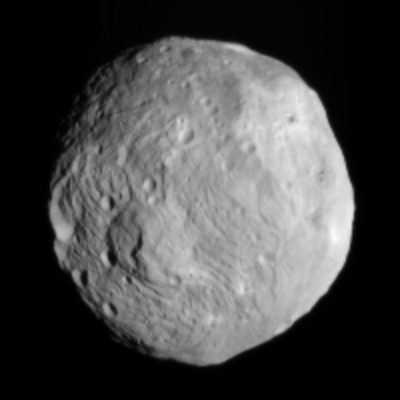
Dawn entered orbit at about 9900 miles (16000 km) altitude after a nearly 4 year journey of 1.73 billion miles.
Over the next few weeks, the spacecrafts primary task is to gradually spiral down to its initial science operations orbit, approximately 1700 miles above the pock marked surface.
Vesta is the second most massive object in the main Asteroid Belt between Mars and Jupiter. Dawn is the first probe to orbit an object in the Asteroid Belt.
I asked Principal Investigator Chris Russell from UCLA for a status update on Dawn and to describe what the team can conclude from the images and data collected thus far.
“The Dawn team is really, really excited right now,” Russell replied.
“This is what we have been planning now for over a decade and to finally be in orbit around our first ‘protoplanet’ is fantastic.”
“The images exceed my wildest dreams. The terrain both shows the stress on the Vestan surface exerted by 4.5 billion years of collisions while preserving evidence [it seems] of what may be internal processes. The result is a complex surface that is very interesting and should be very scientifically productive.”
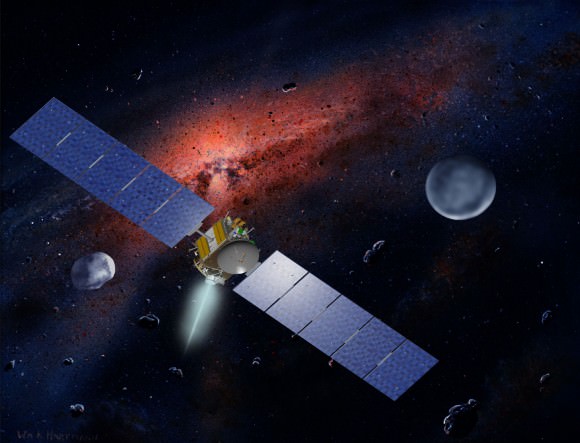
“The team is looking at our low resolution images and trying to make preliminary assessments but the final answers await the higher resolution data that is still to come.”
Russell praised the team and described how well the spacecraft was operating.
“The flight team has been great on this project and deserves a lot of credit for getting us to Vesta EARLY and giving us much more observation time than we had planned,” Russell told me.
“And they have kept the spacecraft healthy and the instruments safe. Now we are ready to work in earnest on our science observations.”
Dawn will remain in orbit at Vesta for one year. Then it will fire its ion thrusters and head for the Dwarf Planet Ceres – the largest object in the Asteroid Belt. Dawn will then achieve another major milestone and become the first spacecraft ever to orbit two celestial objects.
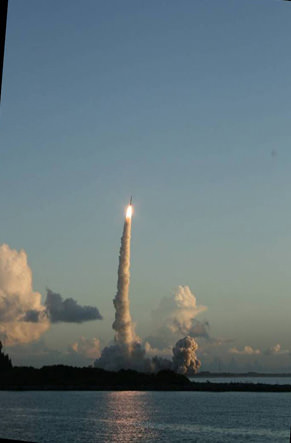
Jim Green, Director of Planetary Science for the Science Mission Directorate (SMD) at NASA HQ in Washington, DC, summed up his feelings about Dawn in this way;
“Getting Dawn into orbit is an amazing achievement,” Green told me.
“Instead of the ‘fire the thrusters full blast’ we just sort of slid into orbit letting gravity grab the spacecraft with a light tug. This gives us great confidence that the big challenge down the road of getting into orbit around Ceres can also be accomplished just as easily.”
Sharper new images from Vesta will be published by NASA in the next day or so.
“We did take a few navigation images in this last sequence and when they get through processing they should be put on the web this week,” Russell informed. “These images are from a similar angle to the last set and with somewhat better resolution and will not reveal much new.”
However, since Dawn is now orbiting Vesta our upcoming view of the protoplanet will be quite different from what we’ve seen in the approach images thus far.
“We will be changing views in the future as the spacecraft begins to climb into its science orbit,” stated Russell.
“This may reveal new features on the surface as well as giving us better resolution. So stay tuned.”
Marc Rayman explained how and why Dawn’s trajectory is changing from equatorial to polar:
“Now that we are close enough to Vesta for its gravity to cause a significant curvature in the trajectory, our view is beginning to change,” said Rayman. “That will be evident in the pictures taken now and in the near future, as the spacecraft arcs north over the dark side and then orbits back to the south over the illuminated side.”
“The sun is over the southern hemisphere right now,” added Russell. “When we leave we are hoping to see it shine in the north.”
Dawn is an international mission with significant participation from Germany and Italy. The navigation images were taken by Dawn’s framing cameras which were built in Germany.
Exploring Vesta is like studying a fossil from the distant past that will immeasurably increase our knowledge of the beginnings of our solar system and how it evolved over time.
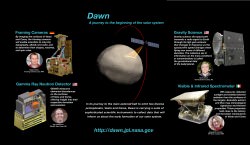
Vesta suffered a cosmic collision at the south pole in the distant past that Dawn can now study at close range.
“For now we are viewing a fantastic asteroid, seeing it up close as we zero in on its southern hemisphere, looking at the huge central peak, and wondering how it got there,” explained Jim Green
“We know Vesta was nearly spherical at one time. Then a collision in its southern hemisphere occurred blowing off an enormous amount of material where a central peak now remains.”
That intriguing peak is now obvious in the latest Dawn images from Vesta. But what does it mean and reveal ?
“We wonder what is that peak? replied Green. “Is it part of the core exposed?
“Was it formed as a result of the impact or did it arise from volcanic action?”
“The Dawn team hopes to answer these questions. I can’t wait!” Green told me.
As a result of that ancient south pole collision, about 5% of all the meteorites found on Earth actually originate from Vesta.
Keep your eyes glued to Dawn as mysterious Vesta’s alluring secrets are unveiled.
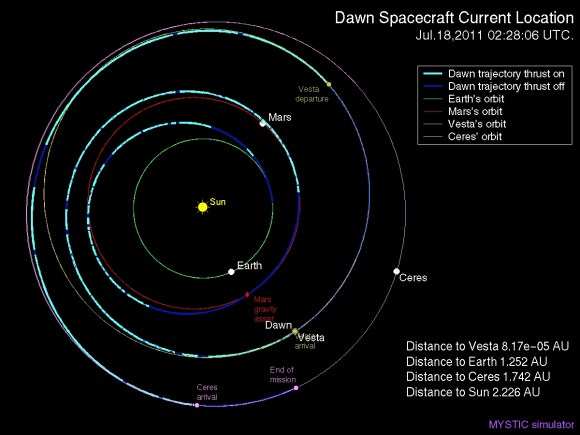
Read my prior features about Dawn
Dawn Closing in on Asteroid Vesta as Views Exceed Hubble
Revolutionary Dawn Closing in on Asteroid Vesta with Opened Eyes

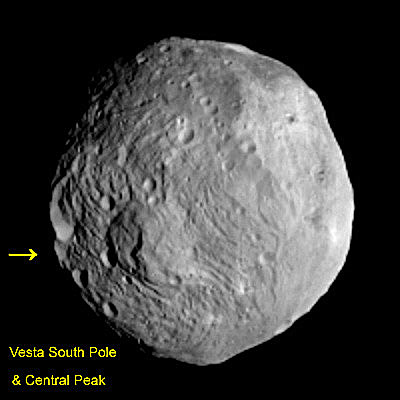
What is a ProtoPlant? (In Main Heading)
fixed
Lol I do that all the time.
I’m a little confused … Dawn has already exceeded their wildest expectations. So they didn’t even expect it would ever arrive at Vesta? Why’d they even plan for Ceres?
It got there earlier than it was supposed to. They didn’t think it could hold it the whole way, but it did, so there were less rest stops.
Also, the visual achievement has surpassed the Hubble as the link stated, give Ken Kremer a little poetic license, he is driving some words in the article after all. He got his learner’s permit a long time ago… and he didn’t buy his adult license from a mall.
Mary
My thoughts exactly. Did they expect it to malfunction and disappear into space, or crash into the first rock it found? Must not think much of the engineers that designed the ship.
I’d agree its an amazing achievement and it seems it has exceeded expectations, but I think hyperbole like “exceeding wildest expectations” should only be used in the case of something like Elvis being found alive and well and still banging out tunes there.
They’re probably just tripping balls-to-the-wall over this achievement, Ken 😉 Good performance translated to awesome, incredible performance. I’d have the same stance had I worked on that little clever machine!
Far far away
Woooooo!!!! this is very exciting and can’t wait for more to come from Dawn.
A protoplanet is a Moon-sized object formed by the accumulation and accretion of planetesimals collisions in the early Solar System. Please see:
http://www.universetoday.com/37053/protoplanets
How does the spacecraft slow sufficiently to orbit this small body? Isn’t Vesta moving at unite high speeds relative to Earth and the Sun? And orbital speed for Vesta surely is quite slow?
I’m not sure I understand the question. To get out to where it is, it has braked more or less continuously, see the last figure.
Wikipedia tells me Earth orbital speed averages ~ 30 km/s, Vesta ~ 20 km/s. Total delta-v ~ – 10 km/s, right?
I think the simpler answer that Michael might have been looking for is this: Vesta is already moving at speed in its orbit around the sun, so by the time Dawn gets there, they’re pretty much moving at the same speed. All Dawn has to do is nudge itself into an orbit.
Of course, Dawn has to go faster to begin with to catch up with Vesta, and then has to slow down… but as you can see from the diagram in the article, most of slowing down will be a result of Vesta’s movement away from the Sun – the same reason comets slow down as they move back out away from the Sun, though obviously the effect is more subtle here.
Occasional thrusting then prevents Dawn falling back towards the Sun, much like the example in Torbjörn’s link.
Thanks everyone…now I see that first the space craft much match the orbital speed of Vesta, which is nearly the same as the speed the spacecraft already has. Then, it uses Vesta’s gravity and the ions to change the vector and go into orbit. Thanks to all.
Is this – Transfer Orbits – the UT article that you were looking for, Torbjörn?
Thanks!
I guess I need to fix an upgrade to my GoogleFu™.
A small point the article notes:
“Dawn entered orbit at about 9,000 miles (16000 km) altitude after a nearly 4 year journey of 1.73 billion miles.”
This should of course read: “1.73 million miles,” the ion propulsion thrusters are not that exotic ….. as yet.
No, it’s billion. 1.73 million miles would barely get it past the moon (well several times further away than the moon, but still near Earth). Space is big.
Good eyes! You are also correct Space is big it’s another billion miles to Ceres.
Take a look at the orbital plot. The spacecraft Dawn went twice around the sun at an average distance comparable to about a Martian orbital radius. Mars is at 204-250 million km, which is an average of 225 million km. So Dawn was at an average of maybe So a distance of two such orbits is 4?R which is equal to 2.8 billion km. The distance from Earth to sun is 1AU = 1.5×10^8km and Vesta is 2.2 AU or an average distance of 1.6AU = 2.4×10^8km. This is an average orbital distance of around 3.×10^9 km. Now multiply by .6 to convert to miles and you have 1.68×10^9miles or 1.8×10^9miles. This is about the distance quoted.
LC
Got that, appreciate your clarification. Have a great day!
Take a look at the orbital plot. The spacecraft Dawn went twice around the sun at an average distance comparable to about a Martian orbital radius. Mars is at 204-250 million km, which is an average of 225 million km. So Dawn was at an average of maybe So a distance of two such orbits is 4?R which is equal to 2.8 billion km. The distance from Earth to sun is 1AU = 1.5×10^8km and Vesta is 2.2 AU or an average distance of 1.6AU = 2.4×10^8km. This is an average orbital distance of around 3.×10^9 km. Now multiply by .6 to convert to miles and you have 1.68×10^9miles or 1.8×10^9miles. This is about the distance quoted.
LC
So when I we sending a lander to follow up?
If the observations call for it, a lander might get considered. But that won’t happen until after years of study of the data sent back by Dawn. Vesta will have to prove itself more worthy of a lander than other asteroids – and personally I think we’ll have more interest in those much smaller asteroids that pose a threat to Earth. We’ll want to know their composition, in case we ever need to blow one up….
One of the best articles I have seen re this mission so far. Im so glad UT went to the effort to get more information then the standard press releases. Good work!
Cant wait for the new images.
“Vesta vistas” — haha, make it stop! We are going to be seeing that “clever” conjunction for a long time. Just say no!
What’s really exciting for me is that ion propulsion is coming of age.No more swinging round gravity wells for years at a time. Let’s hope the success will spur development of VaSIMR drive.
Oh wow, I never even thought about it like that.
http://www.web-anon-tools.us.tc
dam it if i were good in math i would probably be working right now in NASA. If you need a volunteer to go to deep in to space and not come back sign me up please i would gladly do it FOR FREEEEEEEEEEEE LOL =-p
Parece que la misión terminará antes de que llegue a Ceres, pero me impresiona saber que existen mundos tan diferentes e inhóspitos y están tan alejados 4 años a toda velocidad para llegar a ellos. wauhhhh…:)
Bueno creo que la alcanzará a Ceres y será lo último.
Vesta photos very nice ,Jaxa’s Hayabusa Job compare Down ???
Sam.G
SRCOM
Possible hyperbole…
Apollo 8 was the first spacecraft to orbit two celestial bodies. So did Apollo 10, Apollo 11, Apollo 12, Apollo 14, Apollo 15, Apollo 16, and Apollo 17.
This is one “first” that dawn cannot claim.
Apollo 13 needs to be placed within this listing as well.
Mary
Did Apollo 13 actually orbit the moon, or just swing ’round it?
ITSRUF,
You are more correct to say partial orbit than to say swing around it, but you are right it did not make one complete orbit of the moon. The list stands with this removed.
Mary
Glad you were able to confirm a partial orbit of the moon. I was not sure, and couldn’t find info to
@ITSRUF,
I did a hurried search, found the link and glanced at the figure shown below.
http://upload.wikimedia.org/wikipedia/commons/f/fc/Apollo_13_timeline.svg
It seemed to be very well done as a graphic of the timeline and indicated only the partial orbit. The idea of the asterisk would be nice. * Caveat emptor
Mary
Glad you were able to confirm a partial orbit of the moon. I was not sure, and couldn’t find info to